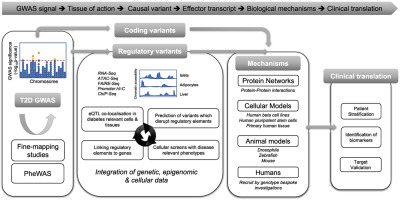当前位置:
X-MOL 学术
›
J. Mol. Biol.
›
论文详情
Our official English website, www.x-mol.net, welcomes your feedback! (Note: you will need to create a separate account there.)
From Genetic Association to Molecular Mechanisms for Islet-cell Dysfunction in Type 2 Diabetes.
Journal of Molecular Biology ( IF 5.6 ) Pub Date : 2020-01-13 , DOI: 10.1016/j.jmb.2019.12.045 Katia K Mattis 1 , Anna L Gloyn 2
Journal of Molecular Biology ( IF 5.6 ) Pub Date : 2020-01-13 , DOI: 10.1016/j.jmb.2019.12.045 Katia K Mattis 1 , Anna L Gloyn 2
Affiliation

|
Genome-wide association studies (GWAS) have identified over 400 signals robustly associated with risk for type 2 diabetes (T2D). At the vast majority of these loci, the lead single nucleotide polymorphisms (SNPs) reside in noncoding regions of the genome, which hampers biological inference and translation of genetic discoveries into disease mechanisms. The study of these T2D risk variants in normoglycemic individuals has revealed that a significant proportion are exerting their disease risk through islet-cell dysfunction. The central role of the islet is also demonstrated by numerous studies, which have shown an enrichment of these signals in islet-specific epigenomic annotations. In recent years the emergence of authentic human beta-cell lines, and advances in genome-editing technologies coupled with improved protocols differentiating human pluripotent stem cells into beta-like cells has opened up new opportunities for T2D disease modeling. Here we review the current understanding on the genetic basis of T2D focusing on approaches, which have facilitated the identification of causal variants and their effector transcripts in human islets. We will present examples of functional studies based on animal and conventional cellular systems and highlight the potential of novel stem cell-based T2D disease models.
中文翻译:

从遗传关联到 2 型糖尿病胰岛细胞功能障碍的分子机制。
全基因组关联研究 (GWAS) 已经确定了 400 多个与 2 型糖尿病 (T2D) 风险密切相关的信号。在绝大多数这些基因座中,主要单核苷酸多态性 (SNP) 位于基因组的非编码区域,这阻碍了生物学推断和将遗传发现转化为疾病机制。对正常血糖个体的这些 T2D 风险变异的研究表明,很大一部分人正在通过胰岛细胞功能障碍发挥其疾病风险。大量研究也证明了胰岛的核心作用,这些研究表明这些信号在胰岛特异性表观基因组注释中得到了丰富。近年来出现了真正的人类β细胞系,基因组编辑技术的进步以及将人类多能干细胞分化为 β 样细胞的改进方案,为 T2D 疾病建模开辟了新的机会。在这里,我们回顾了当前对 T2D 遗传基础的理解,重点关注方法,这些方法有助于识别人类胰岛中的因果变异及其效应转录本。我们将展示基于动物和传统细胞系统的功能研究示例,并强调基于干细胞的新型 T2D 疾病模型的潜力。这有助于识别人类胰岛中的因果变异及其效应转录物。我们将展示基于动物和传统细胞系统的功能研究示例,并强调基于干细胞的新型 T2D 疾病模型的潜力。这有助于识别人类胰岛中的因果变异及其效应转录物。我们将展示基于动物和传统细胞系统的功能研究示例,并强调基于干细胞的新型 T2D 疾病模型的潜力。
更新日期:2020-01-14
中文翻译:

从遗传关联到 2 型糖尿病胰岛细胞功能障碍的分子机制。
全基因组关联研究 (GWAS) 已经确定了 400 多个与 2 型糖尿病 (T2D) 风险密切相关的信号。在绝大多数这些基因座中,主要单核苷酸多态性 (SNP) 位于基因组的非编码区域,这阻碍了生物学推断和将遗传发现转化为疾病机制。对正常血糖个体的这些 T2D 风险变异的研究表明,很大一部分人正在通过胰岛细胞功能障碍发挥其疾病风险。大量研究也证明了胰岛的核心作用,这些研究表明这些信号在胰岛特异性表观基因组注释中得到了丰富。近年来出现了真正的人类β细胞系,基因组编辑技术的进步以及将人类多能干细胞分化为 β 样细胞的改进方案,为 T2D 疾病建模开辟了新的机会。在这里,我们回顾了当前对 T2D 遗传基础的理解,重点关注方法,这些方法有助于识别人类胰岛中的因果变异及其效应转录本。我们将展示基于动物和传统细胞系统的功能研究示例,并强调基于干细胞的新型 T2D 疾病模型的潜力。这有助于识别人类胰岛中的因果变异及其效应转录物。我们将展示基于动物和传统细胞系统的功能研究示例,并强调基于干细胞的新型 T2D 疾病模型的潜力。这有助于识别人类胰岛中的因果变异及其效应转录物。我们将展示基于动物和传统细胞系统的功能研究示例,并强调基于干细胞的新型 T2D 疾病模型的潜力。



























 京公网安备 11010802027423号
京公网安备 11010802027423号